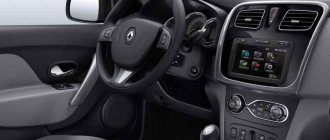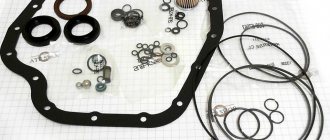Even in a car with such a high degree of reliability as the Toyota Corolla, the automatic transmission needs to be replaced periodically. If the gearbox fails, some consider the best option to contact a service center, while others consider doing all the necessary work themselves.
Even if such work is not included in your immediate plans, knowledge about them will still not be superfluous, since they can become useful at any time.
A word to car enthusiasts
Here is the opinion of a person whose car has nothing broken. But he still feels uncomfortable driving with such specific dynamics.
Review from a car enthusiast
A characteristic opinion about the classic torque converter gearbox.
Review of Toyota Corolla automatic
Reviews about the Toyota Corolla robotic gearbox are different. Some people defend manual transmission: “It’s not that bad.” But is this assessment appropriate for the renowned brand?
Review of the Toyota Corolla robotic box
The author of the following passage is correct in his positive approach.
Review of the 2007 Toyota Corolla
Indeed, everything can be fixed. Everything can be sorted out and fixed. And he did fix it. But our task is to compare. And the author compares: “almost like a real machine!” You have to understand that the dynamics are not up to par. There are no complaints about efficiency, but a lot of effort and money were spent.
Here's another similar comment. It will certainly help someone say goodbye to their problems by replacing the unsuccessful control unit of the first release with a new one.
Car owner review of Toyota Corolla
Quotes from this story speak for themselves:
- MTT has become convenient, almost like an automatic transmission;
- small gaps remain;
- All that remains is to install the upgraded clutch.
Our people are talented and persistent. They study the literature, learn how to properly operate the car, modernize the car, improving its characteristics. I wonder what they are changing and adjusting there? You need to understand the device in order to decide: a Toyota Corolla with a robotic gearbox or an automatic - which is better. Owner reviews aren't everything.
Instructions for replacing a robot with an automatic one on a Corolla
To properly install the automatic transmission, read the instructions I gave below:
- Completely digest the fastenings automatically.
- Install the selector lever for the vehicle.
- Attach the kick-down cable to the throttle valve.
- Attach a device simulating the operation of a robot to the ECU. This way you will avoid errors that may occur while the machine is operating without this block.
The replacement procedure itself is quite simple and does not require special knowledge from the car owner. The main thing is to understand what an automatic transmission is, its structure, and to participate a little in disassembling or rebuilding automatic transmissions yourself.
What will you have to change in the car, if you decide to equip a Toyota Corolla with an A240L gearbox, then you will need to replace:
- gear selector;
- install an additional cooling radiator.
However, if you started installing the U340E, then you will need to additionally change the engine control unit, since it regulates the operation of the machine, change the wire harness, and change the instrument panel. The instrument panel must be changed so that the machine does not go into emergency mode.
Attention! If you do not have experience in repairing automatic transmissions, then it is better not to change the automatic transmission yourself. Let experienced mechanics replace the robot with an automatic transmission.
After changing from semi-mechanical to automatic, you will feel how your car has become fast and listens to you better. The robot refuses service too quickly. Therefore, replacing a manual transmission with an automatic transmission will be the best solution for car owners of a semi-mechanical gearbox.
Read
Automatic transmission repair on Opel
Toyota Corolla manual transmission device
The robotic gearbox installed on the Corolla is a type of automatic transmission, the basis of which is a manual gearbox. It is also called AMT (Automated Manual Transmission).
The difference from a manual transmission is that the functions of shifting gears and squeezing the clutch are entrusted to the robot. For clarity, we can imagine that under the hood of the car an iron man does everything for us. Our assistant has two hands - these are two electric drives (or actuators) that control gear selection. He has one leg - the one that squeezes the clutch (another actuator). They are controlled by the brain - an electronic control unit (ECU).
The system also has some senses. It is equipped with sensors that inform the control unit about the current position and operating modes of the actuators. The difference between a real device and an iron man with lamps instead of eyes is that he places his organs where it is convenient for him, without having a single body (body). So, the control unit is located on the car body, the actuators are fixed to the gearbox, and the sensors are scattered in their places.
Manual transmission Toyota Corolla
The control unit receives information about speed, load and engine speed, input shaft speed, the presence of emergency situations (oil overheating), as well as the tasks assigned to the system. After analyzing the information, he makes a decision and gives commands to the actuators. So, after turning on the ignition, the clutch is released and the engine can be started. We move the control handle to D, release the brake, first gear is engaged, and the car drives.
Toyota Corolla robotic gearbox - pros and cons
Let's consider what advantages and disadvantages await car enthusiasts who purchased a Toyota Corolla with a robotic gearbox.
Controlling a robot box is better?
Toyota Corolla with a robotic gearbox has three operating modes, which should be easy and simple to use. In addition, it warns of malfunctions, helps when starting off, and checks whether the door is closed.
If you close your eyes to the need to manually switch to neutral, then operating an AMT is no more difficult than an automatic transmission, and its functionality is richer.
This statement is true for a fully functional mechanism. When the robot starts to think or twitch the car, no, no, but you have to intervene (change modes). And be nervous.
Pros of AMT:
- Economical.
- Comfort.
- Adaptation to driving style.
- Three driving modes.
But there are also disadvantages:
- Weak dynamics, switching delays.
- Low reliability.
- Tendency to overheat.
- The need for periodic initialization.
- Warm-up required.
- Does not like vigorous driving.
- Unreliable electric drives.
- Afraid of high and low temperatures.
There are no complaints about the efficiency of the robot. Over 100 km it will consume half a liter less gasoline than a classic automatic transmission:
- 6 l, 124 hp, manual transmission 6.7 l /100 km.
- 6 l, 124 hp, manual transmission, 6.9 l /100 km.
- 6 l, 124 hp, automatic transmission, 7.2 l /100 km.
Owners for whom everything works fine (they were either lucky or they improved the gearbox) note that driving is incredibly comfortable.
But what kind of comfort and enjoyment of a quiet ride can we talk about when the car jerks spontaneously, and on the instrument panel you wait for the appearance of a gear and the notorious error p0810.
Possible problems with manual transmission: detailed comments
We are very pleased with the comprehensive and objective reviews of the Toyota Corolla on the robot. They help to reveal the characteristic shortcomings of the mechanism.
Mechanical problems
Common mechanical problems include:
- Worn actuator shaft bushings. The consequence is a misalignment of the shaft, an increase in the friction force in the engagement, an increase in currents, an increase in the temperature of the mechanism and, as a consequence, failure of the mechanism.
- In summer, the gearbox may overheat.
- The clutch overheats, resulting in increased wear. Its resource is several times less than with mechanics.
Here is one of the stories about the modernization of the actuator:
Review from a Toyota car owner
Electrical faults
Common electrical faults:
- In the cold, one of the sensors may fail and the box will be knocked into neutral.
- Burnout of the release actuator motor (the switching mechanism rarely fails).
- Worn actuator motor brushes.
- Malfunctions of the ECU (old model).
The owner's story about electrical faults on the car
At the end of the section on malfunctions, there is an excerpt from a large study on the topic:
Excerpt from the study
Characteristics of the variator box
In itself, a vehicle with a CVT transmission does not stand out among other cars with automatic transmissions. It also has two pedals - gas and brake - and the same lever for switching gearbox modes - P, R, N, D - in general, everything is identical to a traditional “automatic”. However, the CVT itself functions completely differently: this gearbox does not have a fixed first, third or fifth speed. The variator can have any number of speeds, and they all switch smoothly and imperceptibly for the driver of the vehicle.
That is why in such cars there are no hard jolts or switching. There are, in fact, no shifts themselves, as such, since the CVT continuously and smoothly changes the gear ratio as the car accelerates or decelerates. As readers of our site remember, CVTs can be of several types: V-belt, chain or toroidal. The V-belt type CVT is the most common and is installed on most modern cars, including the 2014 Toyota Corolla. Let's take a brief look at the characteristics of the CVT.
Automatic transmission of Toyota Corolla disassembled
Advantages:
- The first advantage, as mentioned above, is a smooth change in the gear ratio, depending on the increase in machine speed;
- High efficiency of cars with CVT;
- Excellent dynamics of the car compared to “mechanics”;
- Preventing wheel slip while driving on ice;
- More convenient vehicle control.
Flaws:
- Short service life, especially when operating a car off-road;
- “Capriciousness” of the unit when operating a car in a traffic jam, in rural areas;
- Expensive maintenance;
- Inability to tow.
2014 Toyota Corolla interior
CVT Toyota Corolla 2014 release
The relatively new 2014 Toyota Corolla is equipped at the factory with a six-speed manual transmission or a continuously variable CVT Mulridrive S. Of course, the CVT itself is of particular interest to potential buyers. Having carefully read the technical characteristics of the Toyota Corolla, you will notice that the CVT modification of the car “eats” 300 grams of gasoline per 100 km of run than the “mechanical” version.
The essence of this gasoline saving lies in the design of the variator, which can use the engine power most efficiently. The dynamics of the car and the smooth transmission of torque in new Toyotas are ensured not only by the CVT unit itself, but also by the system connecting the gearbox to the car’s engine. In 2014 Corolla models, this function is performed by a torque converter.
Automatic transmission Corolla 2014
If you have an idea about the operation of a variator, then you know that the speed of a car is determined by the diameters of the drive and driven shafts of the gearbox. That is, the larger the size difference, the higher the CVT performance becomes. Therefore, the engineers of the automobile concern decided to increase the gap between the sidewalls of the unit in order to obtain the optimal size of the shafts. It should be noted that these modifications did not in any way affect the dimensions of the CVT itself.
The CVT transmission on the 2014 Corolla requires the use of exclusively original gear oil with a lower viscosity percentage. This fluid allows for optimal protection of the variator parts, while simultaneously increasing its operating efficiency by reducing unnecessary losses.
When does it become necessary to replace a robotic gearbox with an automatic one?
The owner’s patience breaks at the moment when, after an unsuccessful struggle with a capricious transmission (fiddling with settings, repeated initialization, replacing components), the driven disk slips. Replacing a new clutch kit is inevitable. This means removing and installing the box, but no one knows whether the torment will end there, or whether everything will go in a new circle.
And then many take a radical solution to the problem - install a classic automatic transmission.









